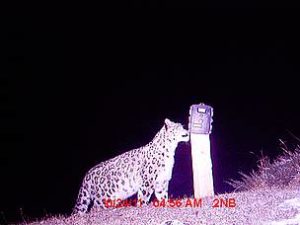Nov 18, 2011
Save snow leopards to save Himalayas
Saving its trans-Himalayan habitat is the first step to saving the species
Bhutan Climate Summit In the face of climate vulnerability in the Himalayan and trans-Himalayan regions, it is important to secure connected climate resilient habitat areas for the snow leopard (Panthera uncia) in the large conservation landscape.
In a presentation on snow leopard conservation and climate change, a conservation scientist of the world wildlife fund (WWF) in United States, Dr Eric Wikramanayake, said snow leopards are a large carnivore with large home ranges, and that an effective snow leopard conservation cannot be done in small fragmented patches. “They need large special areas.”
He also said snow leopards live in a relatively narrow band of alpine habitat, the broken rugged terrain between 3,000 and 4,500m above sea level.
Dr Eric Wikramanayake, speaking during the side event of the upcoming Bhutan Climate Summit, said that a study on the climate vulnerability of this iconic and mystical species in the Himalayas showed that the snow leopard is the top carnivore of the Himalayan mountains, and is actually a species that links three countries of India, Nepal and Bhutan.
“It’s global population, including the trans-Himalayan region and central Asia, is guesstimated at around 4,500 to 7,000 and they occur at a population density of 1 to 5 snow leopards in every 100 sq km, depending on habitat and prey availability, but they are killed and persecuted in all ranges,” he said.
Dr Eric Wikramanayake also said that, based on the biological attributes and threats, snow leopards are listed as endangered species in IUCN Red List of threatened species. “But now a new threat to snow leopard and its habitat looms and that is climate change.”
It is predicted that the temperatures in the Himalayas will increase by three degree Celsius by 2050, and by about 5 degree Celsius at the end of the century. Precipitation is also predicted to increase as the monsoonal rains become more intense, and even exert the influence all the way to the Tibetan plateau.
The conservation scientist said regionally as much of about 30 percent of the alpine habitats will be lost, but more importantly, there will be about 40 percent of habitat loss in Nepal and about 50 percent of loss in Bhutan and about 20 percent in India.
The warmer and wetter conditions are projected to cause flora from the lower elevations to move upslope and intrude into the alpine areas, which is the habitat of the snow leopard, and reduce the extend of available habitat, fragmenting them into small patches.
“As a top vibrant carnivore, with specialised habitat requirement, snow leopards can be considered as an umbrella species, further high Himalayan biodiversity as well as the indicator of the species changes that we expect to take place in these high Himalayan ecosystem,” Dr Eric Wikramanayake said.
Explaining a climate modeling of snow leopard habitat, he said, in the Himalayas, there will be loss of alpine habitat along the southern boundaries of the ecosystem, but there will also be significant intrusion of forests along the rivers that cut into the mountains, isolating and fragmenting the alpine habitat.
The conservation scientists also said it is a must to create a mechanism and forum for conservation and management of the alpine ecosystem. “We need to think about cascading impacts of ecological interactions and work with local communities for sustainable livestock grazing and medicinal plant collections,” Dr Eric Wikramanayake said.
He said that as some of the large mammals that live in the lower forest will also move upslope and begin to compete with snow leopard for resources and some, like in Bhutan, tigers will predate on snow leopards.
Dr Eric Wikramanayake also said there are also other concerns and implication beyond the snow leopard.
He said that people have been using these alpine grasslands for grazing and in recent years, livestock herds have grown considerably, resulting in depredation of physiologically sensitive high altitude grasslands.
“Even now, people hunt wild animals but in future, as resource competition increases in smaller spaces, the intensity of persecution of wild animals is likely to increase, as snow leopard will rely on domestic livestock and this will increase human-snow leopard conflict.”
The conservation scientist said that it is important to adopt these recommendations, as saving snow leopard is not about saving the species but saving Himalayas, saving the high altitudes ecosystem and reducing climate vulnerability of biodiversity, of people, and economies of the countries.
“It’s about sustaining the ecological processes and environmental flows, especially water that affects millions of people far down stream from the actual snow leopard habitat,” Dr Eric Wikramanayake said.
By Tashi Dema
http://www.kuenselonline.com/2011/?p=21201





